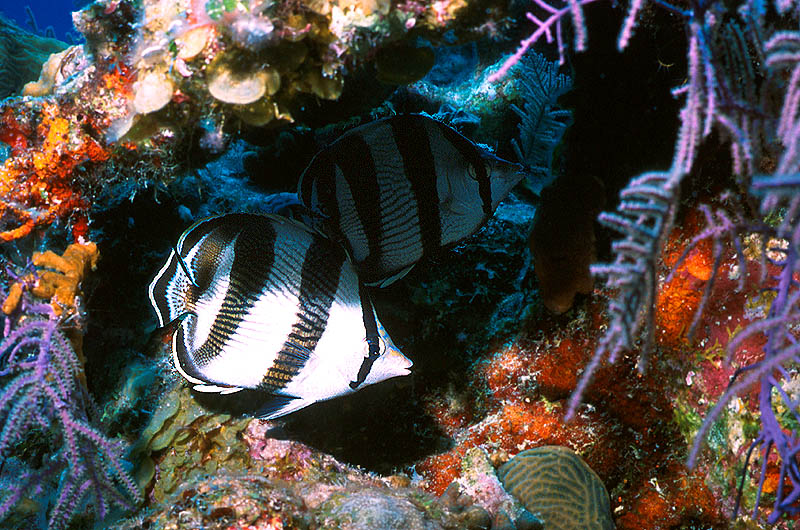
Volume 4 Number 3
Hurricanes and Reef Fish:
Banded Butterflyfish take Shelter


Volume 4 Number 3
Hurricanes and Reef Fish:
Banded Butterflyfish take Shelter

When Hurricanes are over tropical reefs, hurricane winds create huge waves. But reef fish are safe from these huge waves for two reasons. First, waves happen mostly at the surface. That is, although the water at the surface of the ocean is moving a lot, water just a few feet below the surface is mostly calm. The up-and-down motion of the waves is damped out, and the water below the surface moves mostly from side to side. This side-to-side motion is called surge. The surge is not too different from ocean currents that flow around the reef most of the time. Second, even if the surge is bigger than normal ocean currents, there are plenty of places for reef fish to hide. In the cracks and crevices of the coral reef, the motion of the water is not too bad. And the deeper these fish go, the less they feel the effects of the surge caused by the waves overhead.
This picture shows a pair of Banded Butterflyfish hanging out in a small cave in the reef. Tessa Dowell saw these fish at a reef called Rolling Hills near Grand Turk.
As we've learned in previous issues of e-ReefNews, Banded Butterflyfish have long snouts that let them reach into small holes to catch worms and other animals they eat. This picture shows the Banded Butterflyfish's long, tapered snout. Their jaws are like tweezers that can reach into tight places to pull out their food.
Notice the second Banded Butterflyfish farther back in the shadows. These two Banded Butterflyfish are a "husband and wife," a mating pair of fish that will stay together for most of their lives. Many Butterflyfishes and Angelfishes live together as mated pairs. Such mated pairs will always be close together as they swim around the reef. Compare these Banded Butterflyfish to pictures of mated pairs of Butterflyfish and Angelfish on the ReefNews website at
http://www.reefnews.com/reefnews/photos08.html
These Banded Butterflyfish were each about 6 inches long.
Also notice the colors in the reef around these Butterflyfish. This area of the Rolling Hills Reef was encrusted with bright red and orange sponges. There are a few small, round, green leaves of simple plants called algae. The tall purple branches are corals. You can see the tiny white coral animals (called polyps) sticking out from many of these branches. Each polyp is less than 1/4 of an inch long.
--------------------
e-ReefNews and embedded illustrations are
Copyright © 2002 ReefNews, Inc.
ReefNews ® is a registered trademark of ReefNews, Inc.